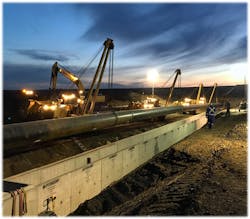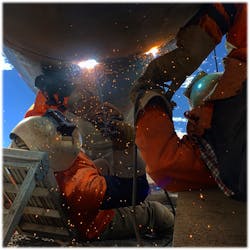Primoris Willbros Canada completed its first project in Canada in 1923. In the nearly 100 years since, the company has grown and positioned itself as a leader in hydro-transport pipeline construction and maintenance, construction and repair of storage tanks, facility construction, piping fabrication and pipeline integrity services. The company serves major firms in the oil, gas, power, petrochemical and heavy oil industries and has established itself as a safety leader in these markets.
Based in Edmonton, AB, with a branch office in Ft. McMurray, AB, the company takes pride in its exceptional safety performance and corporate HSE manager Kim Taylor and HSE director Shelley Hassen attribute much of that success to innovative programs and the over 500 engaged employees and leaders in the company.
The two safety professionals have experienced tremendous success engaging employees and reducing injuries and illnesses. Both of them understand the challenges facing employees on a day-to-day basis. They have both worked at the company for 10+ years and came to their positions in safety via different but complementary paths.
Taylor started her career as a laborer at a pipeline company in 2006. In 2007, her employer was acquired by what was then Willbros Canada. After working on various crews and positions, she transitioned to a safety role in 2009.
“I made the decision to get into safety because I understood the work and the challenges our employees faced,” says Taylor. “I began taking HSE courses and achieved a field level HSE advisor position in the summer of 2009. From 2009 until April 2017, I worked on multiple projects and client sites in various HSE roles until moving into the corporate HSE manager position. I wanted to make a difference [and] be someone our workers looked up to and respected because they knew I had the field experience along with the HSE knowledge.”
Hassen joined the company in 2007 as a part-time administrative assistant to the health and safety manager and the rest, as they say, is history. “I didn’t even know that safety was a career choice at that moment,” she remembers. “I knew I had found my calling, I worked hard at understanding our work and safety systems and moved my way through the organization.”
Challenging Work
Construction work can be challenging under the best of circumstances. Add in a harsh climate and sometimes punishing construction and operations schedules and things really can get tough, agree Hassen and Taylor.
A few of the safety challenges faced by the Primoris Willbros Canada workers are related to the wicked weather conditions found in northern Alberta, including snow and freezing temperatures in the winter and hot summer months. In winter, temperatures can drop as low as -22 to -40°F for short periods of time, and while average snowfall in much of province usually doesn’t go above 12-24 in., the ski resorts of the Canadian Rockies can see up to 30 ft. of snowfall between November and April.
Other challenges include scheduling pressures, client influence and ensuring that employees understand and follow procedures.
Within the oil and gas industry, it is common that workers also face uncertainty about when and where their next job is going to be, which can cause distractions at work. Plus, every worksite is different, and adjustments need to be made to programs to accommodate the different client rules and procedures.
The changing scope of the work performed at each site has been challenging as well. Taylor says the company has ventured into numerous different scopes of work than what it did several years ago. Previously, the company was engaged in large, cross-country pipeline projects. Now, the focus has changed, evolving from those larger scale projects to smaller scale pipeline construction and maintenance, tank construction, and facility work including electrical scopes.
“We’ve had to adapt, learn and improve our safety manual to include additional work scope,” says Taylor. “Plus, working in multiple provinces creates its own challenges due to each province having its own legislation.”
“It’s challenging when you have one [safety] system that needs to work everywhere,” Hassen adds. For example, they had to write a new electrical safety program to accommodate the addition of electrical work as part of the services they offer clients. “Our safety management system is very pliable, very flexible,” says Hassen, adding, “It’s strategic.”
Looking at the big picture, that means that changing work and changing working conditions must be accommodated by the safety process and employees must be engaged and understand expectations in order to work safely.
Empowering Employees
Back in 2011, there were a few significant safety-related incidents that forced Willbros Canada to reflect on where the gaps were in its safety process. Gaps “not just in our procedures,” Hassen explains, “but in how we were engaging our people. Since that time, we’ve really empowered them and encouraged them to own their safety. ‘Why do you work safe? Own that.’ It took time to earn that trust but it’s there now and it’s amazing.”
According to Hassen, “It’s not about relying solely on the supervisor to set the safety message. It’s about ensuring the employees know what our expectations are; that that they are expected to say no to tasks or work situations they think are unsafe. They know our expectations; they are empowered to say no; and they know they can trust that process.”
Taylor added that while she was conducting research about effective safety cultures, this concept stood out to her: “Safety culture is the end result of combined efforts towards the values, attitudes, goals and proficiency of an organization’s HSE program.”
“Our safety culture is constantly evolving. We have set goals, hold employees and supervisors accountable and truly have buy-in from all levels of the organization,” says Taylor, who admits it’s a shift in the right direction that’s occurred over the past 11 years. “Employees are not afraid to raise their hand when something is not right. They aren’t afraid to speak up, ask questions, challenge us and suggest ways to improve our process or documentation. It shows where we’re at in our organization with our culture. Having a lot of long-tenured employees who know the work and understand our safety program also helps.”
What also helps are some of the innovations that the HSE department have introduced as part of their efforts to continuously improve the safety culture.
EHS Innovations
There have been some significant initiatives introduced to improve engagement efforts at Primoris Willbros Canada. Some cost money, some are free, and all are effective, according to Taylor and Hassen.
Why I Work Safe Walls
The organization began asking employees to think about their own safety through the introduction of “Why I Work Safe” walls. Every new worker is introduced to the wall as part of the orientation process.
“Each member of our organization brings photos of what means the most to them: kids, vacations, hobbies, family… whatever means something to them,” says Taylor. “We put those photos up on the walls of the lunchroom as a reminder to them to work safe every day, so they can go home to what they love.”
The Safety Talisman Coin
Hassen says another innovative idea was implemented after a significant incident in the organization in 2011. “The investigation determined that our processes, procedures and training were in place, but unfortunately, a decision was still made that day that ended up costing our worker everything,” she says.
“The coin is intended to act as a visual and tangible reminder for our employees to keep safety front of mind. We hope it reminds them to face each task, both at work and at home, with the motivation of why we must perform work safely—to provide for ourselves, our families and to enjoy the things we do outside of work,” Hassen adds.
All employees are presented with a Talisman coin and encouraged to find their own meaning behind it in hopes that it will trigger those motivations and personal choices that make people invest in their safety and the safety of those around them.
“It’s one of my favorite things. We hand them out like candy,” says Hassen. “People give them to their children when they start driving. They give them to loved ones in the hospital. The coins are given to employees by their supervisor, and that gives the supervisor an opportunity to have a one-on-one conversation about why safety really matters to them.”
Taylor said the company still has employees who carry with them—every day—the Safety Talisman coin they received when the program was first rolled out in 2011.
Got Your Six
Hassen laughs about one program that “didn’t seem to have any buy-in when launched, but when we surveyed our employees, it came up high for engagement.”
According to Taylor, the program consists of one phrase: “Got Your Six.” “The program is intended to help foster mutual respect, build trust and generate a greater sense of community; to exemplify ‘my brother’s keeper’ in a structured and purposeful format. It means we’re watching out for each other and encouraging interventions when you see something unsafe. Really, it’s just a slogan but the meaning of it speaks to workers,” she explains.
Safety Is Every Day
While not a new concept, the fact that safety messages are shared with employees every day is important to engagement efforts at the company. The way the company shares safety information is new and innovative, however.
Every morning, entire project groups get together for a safety meeting or a toolbox talk. Field locations review specific tasks and conduct pre-task planning and review any procedures related to those tasks and conduct and update hazard assessments. At the end of shift, closeout meetings are held to debrief the groups on the day’s work, discuss if there were any issues or concerns with the day’s work that may affect the planned work for tomorrow, ensure any work permits have been closed out, discuss if there were any injuries or incidents (that were not previously reported), and address if the work area has been cleaned and deemed safe to leave for the day.
Taylor says that one of the larger programs they’ve implemented to support continuous improvement are monthly HSE scorecards. “The scorecard reports key measurables such as: leading and lagging indicators, compliance to the HSE management system, training compliance, cultural initiatives and environmental initiatives. It is true to say that ‘what gets measured gets done.’ The monthly scorecard process promotes friendly competition between the business units and projects while being held accountable. This program has really been a step change for us over the past few years.”
The use of Intelex and its applications has been a step toward supporting continuous improvement as well, she adds. “Incident management, correction action management, training management, document control... Intelex has helped us with continuous process improvement.”
Engaging Employees through Safety Bulletins
Another innovation recently introduced at Primoris Willbros Canada was the use of safety bulletins. Taylor and Hassen were searching for a tool to engage employees with safety in a way that just took a couple of minutes to have an impact.
They found that safety bulletins, created through their access to Intelex software, were an easy, quick way to communicate information. “In a world full of tech-savvy individuals this application and communication method has brought us into the future,” states Taylor. “E-mails get lost in inboxes; bulletins are a new and easy way to communicate short, important content.”
She said they examined their own organization and asked employees what type of information they’d like to see communicated through these bulletins. One thing they heard is that the bulletins didn’t always have to be about safety; sometimes people wanted updates on company events and project awards. Taylor’s advice: “Keep messaging relevant to your own company. For example, if the company experiences a safety milestone or receives an award, share that.”
“Our work is diverse and employees are scattered among different sites,” says Hassen. “People can get siloed in their own groups and don’t always understand what other groups in the company are doing. Communicating something like a new project that’s been awarded to the company is important so that everyone can feel connected and understands how diverse we are.”
Taylor suggests, “Use feedback [from employees] to adjust what you are communicating to ensure the content is relevant and that the frequency is what they want to see. When you’re first starting, develop a calendar for the delivery of bulletins that outlines what type of information and when the bulletins will be distributed. This type of structure really helped keep us on track.”
The feature of linking documents and other records in Intelex to the bulletins is particularly useful for Taylor and Hassen. “We like the feature of linking our own documentation; it makes the bulletins truly about us and our company,” saya Taylor.
“They are a short, easy, refreshing read,” says Hassen of the bulletins, but adds that they also provide employees with “the full story” by sending them to the full document for detailed information. “We love the response buttons like ‘Show Me More.’’ It gives them the choice to dig in further, and shows that they are interested in the subject,” she says.
Taylor and Hassen also like the fact that the bulletins can be customized and allow them to adjust their approach as needed. Taylor points out that a new rigging and hoisting standard is being published and she and Hassen are considering using bulletins to help roll it out. The bulletins will allow them to share knowledge about any new expectations and improvements found within the new standard, as well as link to the new document.
Both Hassen and Taylor agree that the response to the bulletins has been good. And the feedback about a particular bulletin or topic is immediate, says Taylor, with no additional work necessary for her or Hassen: “Employees click the “Like” button and move on.”
Advice from the Experts
If you want safety success and engagement like that achieved by Primoris Willbros Canada, approach safety in a realistic and achievable way, suggests Taylor, who adds, “Don’t overcomplicate things. Listen to your workers. Involve all aspects of the organization in improvement. If you involve your employees, there will be a sense of ownership and a greater chance of buy in.”
Hassen suggests giving new initiatives time to work. “Many organizations will institute a ‘fix’ and if they don’t see instant results, they add another program. It takes time to turn a safety culture around. If you believe in something enough to invest time and money to introduce it, then give it time to have some impact. We’ve been working on some of our programs for eight years and still are finding ways to improve them.”
Taylor says she knew the safety culture was improving when employees started to challenge her and question why they were being asked to do certain things. “It means they’re reading our documentation [a process, program or standard] and wanting clarity,” she says. “When I got a call from a superintendent who said, ‘I’m trying to understand what this means [how it will impact],’ I knew we were on the right track.
“Our employees—at every level—genuinely want to do the right thing,” Taylor says. “And it’s our job as HSE to be there every step of the way to provide support and offer guidance.”
Sandy Smith is global content lead for Intelex Technologies Inc. An award-winning journalist, Smith has written about occupational safety and health and the environment for 25 years.


